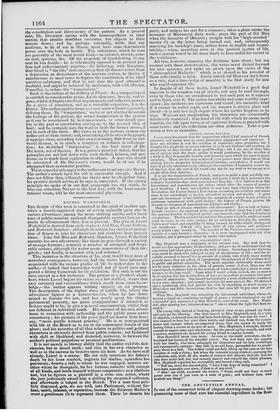THE ANDALUSIAN ANNUAL,
Is one of the numerous tribe of elegant drawing-room books; but possessing more of that rare but essential ingredient is tb.e fleet- ing novelties of the season, e• macter, than most others of its class; not excepting even some of higher pretensions. Its at- tractions consist of a dozen highly-coloured and striking sketches of Andalusian costume, illustrated by slight narratives of the adventures of the real and supnosed originals ; some smooth and pretty verses, and several national airs. The volume is edited by Mr. HONAN, author of the Court and Camp Don Carlos, which we reviewed some months ago; and its materials were picked up by him during his sojourn in Spain as Carlist correspondent of a morning paper. The costumes are lithographed by GAUC I, from the. original drawings by Jose BEceuea, an artist of Seville ; and so far as they are faithful copies of them and characteristic delineations of the costume, they are curious and interesting : as works of art they are of no value. LEWIS has made us so familiar with the Bullfighters and Contrabandistas of Spain in his masterly Sketches, that these drawings—which are, to say the least, crude and commonplace in comparison—have not all the freshness of novelty. Still there is a charm in their very homeliness, for it gives assurance of truth : their " infinite beauty," of Odell the editor speaks, is beyond our finite perceptions. The Matador PEPE, ttho was gored to death by a bull in the arena, meeting the rush of the beast with his sword ; the Bandit JOSE CARDER° —a villain with a hang-dog look ; the Contrabandist and Brigand JOSE MARIA, wrapped in his large cloak—the same who figures in LEWIS'S work, though there is no resemblance between the two faces ; and a variety of Donnas and Majas in their ordinary dresses, give a lively idea of the every-day appearance of the people. MA• TILDA DIEZ, the actress, is the most pleasing face ; but all the women are so much alike that we doubt the correctness of the resemblance.
The music of this volume is not the least interesting portion of its contents. National melodies tell us somewhat of national character, which we can no other way learn so well; and it is curious to trace the varied application of music in differ- ent countries and ages. The strains which in one nation are used to convey plaintive expression, in another are employed to indicate boldness and martial intrepidity. The predominant use of the minor mode is common to all national melodies ; but we should scarcely anticipate that the song of the smuggler— daring and ferocious—should suggest, in any country, a plaintive melody with the lesser third. Such is the air "El Contra- bandista" in this volume. Sonic of the melodies seem purely na- tional, and contain traits of great beauty—especially "Un navio:" others are evidently of recent date, and are sprinkled with Ita- lianisms.



























 Previous page
Previous page